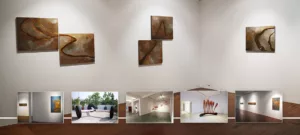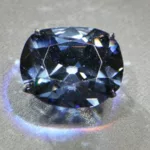Instigating a whirlwind of feelings, the lobby of Deepak Talwar Galleries in New Delhi and New York are gems that induce nostalgia, glee, melancholy, rage, and a vast array of senses. The place exudes a certain kind of warmth in its aura that not many art galleries have in this contemporary world.
Shambhavi Singh’s Maati.Maa, displayed in New York, weaves a perfect blend of the earthly hues: Blue, white, brown, caramel, orange, and black. Most of the art enthusiasts, visiting the gallery, could almost feel the cold wet muddy ground emanating a peaceful essence of petrichor.
It’s an offspring of Shambhavi Singh’s three-decade career as an artist. Her deep interest in Mother Earth’s blushes stems from her childhood memories of rural Bihar, where agriculture defined the lives of the locals.
Ranjani Shettar is another name worthy of a standing ovation for her work- Bubble trap and a double bow. The clever use of distorted and rotund shapes might throw a viewer in a bubbly trip. One of the patrons of Deepak Talwar called ‘How long before another turn’ an exceptional display of the chaos theory, “Within a random and chaotic spawn, a pattern appears.” Her work is presented in the Delhi chapter.
The works of virtuosos in such galleries do not just connect you to the culture of a place, but also intensely engage the onlooker with an intellectual aura. Art, after all, is a sensory stimulator, and renders intellectual gratification.
For instance, these gracious examples of creativity wouldn’t have been possible had Deepak Talwar not seen Nasreen Mohamedi’s line-based minimalistic art in 1989. The canvas spoke to him. Then a young banker, Deepak Talwar chose to pursue the passion, ducked beneath his heart: Art.
Mr. Talwar could not phrase his feelings in words and certainly, he was failing to understand what evoked such a reaction. All of this happened more than 20 years ago, when Deepak Talwar was interested in economics and numbers.
The magic he experienced prompted him to recreate it and share his newfound delight with the world. A few years later, Deepak Talwar founded Talwar Gallery, New York in September 2001. He established Talwar New Delhi in 2007.
But over the period of time, there have been tremendous changes as to how art is viewed, and experienced by collectors. A decade back, galleries had more people enjoying the work of the virtuosos.
With the advent of the Internet, where almost every renowned artist has online presence or collaboration with online art galleries, the approach towards viewing art has changed to a great extent. There are numerous online projects which are aimed at making cultural institutions more accessible by digitizing art collections.
Art is now mostly viewed online in communities, along with critical reviews which are readily available with the paintings. Therefore, the passion of leaving the house to visit the gallery has become subdued for some, and the numbers of visitors have considerably decreased. There is also a flip side; with the success of e-commerce, some lesser known artists believe that that online marketing of the work would be more beneficial to their career.
On the contrary, most artists and dealers are aware of the fact that true connoisseurs judge art by experiencing it from a close distance. To them, viewing or buying artwork on the Internet is like viewing landscapes on the Internet, without travelling and experiencing it in real.
If you’re bored and want to go on a roller coaster of visual treats and emotions, don’t miss the art galleries that Deepak Talwar has worked so hard on. Give it a visit with your friends and family and experience art stenciled around a plethora of issues.








